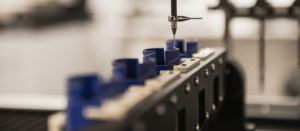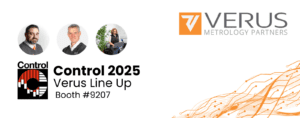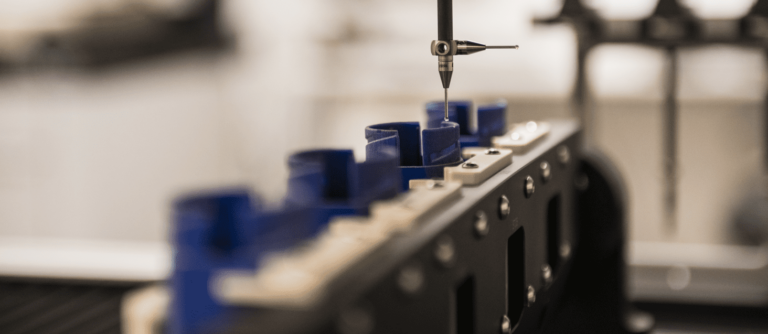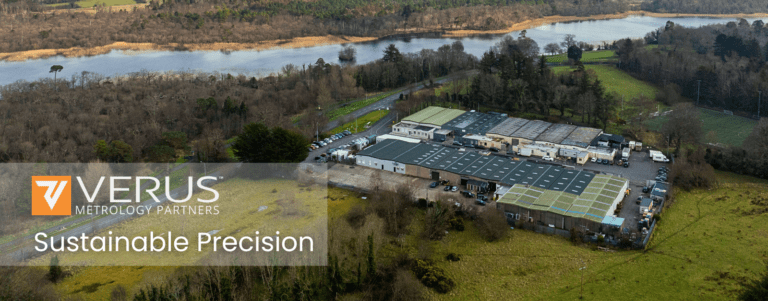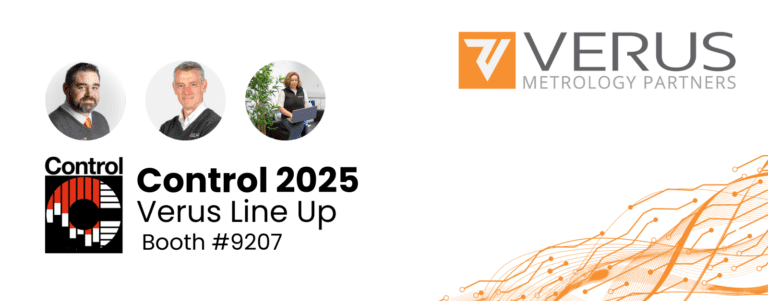The Fundamentals of Metrology Verification and Calibration
Metrology, the science of measurement, plays an essential role in ensuring the accuracy and reliability of measurements across industries like MedTech, Pharmaceutical, Aerospace, and more. Two of the key pillars within this field are verification and calibration, which are fundamental processes in maintaining the precision and performance of metrology systems.
Verification refers to the process of checking that a measurement system or instrument meets the specified accuracy standards or tolerances. It involves comparing the performance of the system against a recognized standard to ensure it delivers consistent, reliable results. Verification ensures that the instrument remains within its designed operating parameters, maintaining the integrity of the data it produces.
On the other hand, calibration is the process of configuring and adjusting measurement instruments to align with known values or standards. Over time, even the most advanced and well-designed instruments can drift or lose their precision. Calibration restores their accuracy by systematically identifying and correcting deviations.
For industries that depend on highly accurate measurements, such as medical device manufacturing or aerospace engineering, these processes are non-negotiable. Even minor discrepancies in measurements can lead to significant issues, ranging from non-compliance with regulatory standards to costly product recalls.
In this article, we will explore why metrology verification and calibration are critical to maintaining measurement accuracy and reliability. We will delve into the processes involved, the tangible benefits they provide, and the consequences of neglecting these essential procedures.
Why Verification and Calibration Are Essential in Metrology
In precision-dependent industries, the accuracy of measurement tools and systems is fundamental. Verification and calibration ensure that these tools maintain their precision and operate reliably over time. Let’s explore why these processes are indispensable in metrology.
Ensuring Compliance with Industry Standards
Many industries, especially those like MedTech and Pharmaceutical, are heavily regulated. Companies must meet stringent quality standards such as ISO 17025 or FDA regulations for product safety and reliability. Verification confirms that instruments and systems are operating within acceptable parameters, ensuring compliance with these industry standards. Calibration, on the other hand, ensures that the measurement instruments can consistently produce accurate results as required by these standards.
Without regular verification and calibration, companies risk non-compliance, which can lead to costly penalties, production halts, and even product recalls. In industries like MedTech, where the quality of products directly affects patient safety, this could have serious consequences.
Preventing Costly Defects and Recalls
A lack of accurate measurements can lead to faulty products making their way into the market, which may result in product recalls. For example, in the production of medical devices or aerospace components, even a tiny error in measurement can result in products that fail to perform as expected, creating safety risks or performance failures. Verification and calibration serve as preventative measures, reducing the likelihood of such defects and ensuring that manufacturing processes are accurate and efficient from start to finish.
When instruments are verified to meet specifications and regularly calibrated, manufacturers can trust their data, improving product quality and reducing the risk of costly issues downstream.
Enhancing Operational Efficiency
Beyond compliance, verification and calibration play a vital role in improving the overall efficiency of manufacturing processes. Consistently accurate measurement tools ensure that production processes run smoothly, reducing the risk of rework and material waste. When tools drift out of tolerance, it can lead to inefficiencies such as production slowdowns or even halts while problems are diagnosed and corrected. Regular verification and calibration help avoid these operational disruptions, keeping production lines running at optimal speed.
By ensuring that measurement systems are accurate and reliable, companies can also improve throughput, reduce downtime, and limit the need for unnecessary corrective actions. This leads to better productivity and a stronger return on investment (ROI).
Maintaining Measurement Integrity Over Time
Over time, even the best-designed instruments may experience wear and tear, environmental effects, or drift, leading to inaccuracies. Regular calibration identifies and corrects any such deviations, ensuring that the instruments continue to provide accurate measurements. Calibration not only maintains the instrument’s integrity but also enhances its lifespan, ensuring that companies can get the most out of their investment in metrology equipment.
Verification further assures that measurement tools are meeting the required standards, which helps organizations stay on top of their quality management practices. When integrated into a company’s regular maintenance schedule, these processes safeguard against unexpected measurement errors and ensure the longevity and reliability of metrology tools.
Key Benefits of Verification and Calibration in Manufacturing
The processes of verification and calibration are not just technical requirements but essential practices that offer multiple tangible benefits to manufacturing operations. Their impact is seen across the product life cycle, from ensuring high-quality production to safeguarding against costly mistakes. Here are some of the key benefits:
1. Ensuring Regulatory Compliance
In industries like MedTech and Aerospace, regulatory bodies such as the FDA, ISO, and other national or international standards organizations impose strict guidelines for product safety and quality. Verification and calibration are vital to maintaining compliance with these regulations. Instruments and systems must be verified to ensure they meet the precise measurement standards required for products, particularly in fields where minute inaccuracies can have significant consequences, such as medical device manufacturing.
Through regular verification and calibration, manufacturers can demonstrate their commitment to quality and compliance, which is crucial for passing audits and maintaining industry certifications.
2. Reducing Waste and Improving Efficiency
Accurate measurements lead to more efficient production processes. When instruments are out of calibration, even by a small margin, it can result in the production of defective components that don’t meet specifications. This not only causes material waste but also increases the time and resources spent on reworking or scrapping non-conforming products.
By maintaining properly calibrated equipment, manufacturers can minimize waste and improve overall efficiency. Verification processes ensure that the equipment remains in spec, providing confidence in the data and reducing the likelihood of costly errors or rework. This contributes to a leaner, more efficient operation, directly impacting the bottom line.
3. Enhancing Product Quality and Consistency
Product quality is inherently tied to the precision of the manufacturing process. Inaccurate measurements lead to inconsistent products, which can affect both performance and safety. Verification and calibration ensure that the tools used in production deliver consistent, repeatable, and reliable measurements, enabling manufacturers to maintain high standards of quality.
This is particularly critical in sectors such as MedTech, where product reliability is paramount to patient safety. Regular calibration helps maintain the high levels of accuracy needed to produce consistent products, ensuring that each item meets the required specifications, no matter when or where it is produced.
4. Preventing Downtime and Production Delays
Unscheduled downtime can be costly for any manufacturer, especially when it results from equipment malfunctions or inaccuracies in the measurement system. Instruments that fall out of calibration may cause delays as operators spend time troubleshooting and correcting issues that could have been prevented. Regular verification and calibration help avoid these disruptions by catching problems early before they lead to significant downtime.
Moreover, properly maintained instruments and measurement systems help streamline production, reducing the need for troubleshooting and minimizing the chances of unexpected delays. This ensures that production schedules remain on track and orders are fulfilled on time, which is crucial for maintaining customer satisfaction and operational efficiency.
5. Reducing Risk of Product Recalls
Product recalls are costly and damaging to a company’s reputation. In industries where precision is critical—such as aerospace, automotive, and medical device manufacturing—errors in measurement can lead to flawed products reaching the market. This not only jeopardizes the safety of the end-users but also increases the risk of expensive recalls.
Verification and calibration significantly reduce the risk of such outcomes by ensuring that the measurement systems in place are accurate and reliable. Consistent calibration ensures that deviations are detected and corrected long before they affect the product’s quality. By adhering to a stringent verification process, companies can prevent the release of defective products and the subsequent fallout.
6. Extending Equipment Lifespan
Proper calibration and verification can also extend the useful life of metrology equipment. Over time, all instruments experience wear and tear, leading to drift or loss of precision. Without regular maintenance, this can lead to premature failure or the need for costly replacements.
By incorporating verification and calibration into a regular maintenance routine, manufacturers can identify and correct minor issues before they become major problems. This preventive approach helps maximize the lifespan of the equipment, allowing companies to get the most out of their investment in high-precision tools.
Verification and Calibration Processes: What’s Involved
The processes of verification and calibration in metrology are precise and highly structured, designed to ensure that measurement instruments and systems perform as expected and adhere to strict standards. These processes are integral to maintaining the accuracy of equipment over time and are a critical part of quality control in manufacturing environments.
Verification Process: Ensuring Performance Against Standards
Verification is primarily a comparative process. It involves checking the measurement tool or system against a known standard to confirm that it is performing within its specified tolerance limits. Verification doesn’t adjust the instrument itself but evaluates whether it is still operating as expected. The goal is to confirm the system’s accuracy and reliability without altering its functionality.
Steps in the Verification Process:
- Preparation and Documentation: The first step involves preparing the necessary documentation that outlines the equipment specifications, operating tolerances, and the standards or benchmarks to be used in the verification process.
- Inspection and Measurement: The instrument undergoes a series of checks where its measurements are compared against known standards. For instance, in a coordinate measuring machine (CMM), the probing system may be verified using calibrated artifacts, such as gauge blocks, to see if it measures within acceptable tolerance ranges.
- Data Analysis: The collected measurements are analyzed to determine whether the instrument is operating within the required accuracy limits. If the instrument falls within acceptable parameters, it is verified and deemed fit for use.
- Reporting: The results of the verification process are recorded in a report, detailing whether the equipment passed or failed the verification check. This report also includes recommendations for further action if necessary, such as recalibration or repair.
Verification is typically done periodically, based on the operational intensity of the instrument or when a significant change in performance is suspected. It’s a critical step in maintaining confidence in the measurement data used throughout manufacturing processes.
Calibration Process: Adjusting and Optimizing Accuracy
Calibration, unlike verification, involves adjusting the measurement instrument to align its readings with known standards. Over time, instruments can drift due to environmental factors, wear, or mechanical stress, leading to inaccurate measurements. Calibration corrects these deviations by tuning the instrument to its correct settings.
Steps in the Calibration Process:
- Initial Measurement Check: The instrument’s current measurements are first checked against reference standards. This establishes a baseline for how much adjustment is needed. These standards might be high-precision reference objects, such as certified gauge blocks, micrometers, or other calibration tools with known and traceable dimensions.
- Adjustment and Correction: Based on the deviation observed, the calibration engineer makes the necessary adjustments to bring the instrument back into alignment with the standard. This could involve adjusting software parameters in digital equipment or fine-tuning mechanical components in analog devices.
- Post-Calibration Testing: After the adjustments, the instrument is tested again to confirm that the calibration was successful. This ensures that the instrument is now functioning within its specified tolerances.
- Documentation: A calibration certificate is issued, which includes detailed records of the adjustments made, the current measurement accuracy of the instrument, and the traceability to the standards used in the calibration process. This documentation is critical for audits and quality assurance purposes.
Calibration is essential for all precision measurement equipment, from small handheld devices like micrometers to complex machinery like coordinate measuring machines (CMMs). It is typically performed at regular intervals, depending on the instrument’s usage and the required measurement precision in the production environment.
Tools and Techniques Used in Modern Metrology Labs
Today’s advanced metrology labs are equipped with tools and techniques to ensure that verification and calibration processes are both accurate and efficient. Common equipment includes:
- Coordinate Measuring Machines (CMMs): Used for highly precise measurements of complex geometries. CMMs are often verified and calibrated using certified reference standards to ensure their probe systems and measurement capabilities are accurate.
- Laser Interferometers: These are often used for calibration in situations where extreme accuracy is required, such as in aerospace or high-precision manufacturing. Laser interferometry measures minute changes in position with exceptional accuracy, making it ideal for calibrating linear axes in machine tools and CMMs.
- Gauge Blocks and Standards: These are essential in the calibration of dimensional measurement tools. Gauge blocks are highly accurate reference standards used to calibrate instruments like calipers, micrometers, and CMMs.
- Temperature-Controlled Environments: Since temperature can significantly affect measurement accuracy, modern metrology labs, such as those operated by Verus Metrology Partners, maintain strict temperature control during both verification and calibration procedures to minimize thermal expansion or contraction effects.
Automated Calibration Systems
With the rise of Industry 4.0, automated calibration systems are becoming increasingly prevalent. These systems reduce human error by using software-driven procedures to calibrate and verify instruments automatically. The integration of automated calibration systems helps maintain the accuracy of equipment without the need for manual intervention, improving both speed and reliability.
Real-World Applications of Verification and Calibration
Verification and calibration are essential practices across multiple industries, ensuring that precision measurement tools and systems function reliably and consistently. Their impact is profound in sectors like MedTech, Aerospace, FMCG, and others where product quality and safety depend on precise measurements. Here are some real-world applications of these processes:
MedTech: Precision and Patient Safety
In the MedTech industry, verification and calibration are critical to maintaining the safety and functionality of medical devices. Whether producing surgical tools, diagnostic equipment, or implants, manufacturers must meet incredibly tight tolerances to ensure patient safety. For example, in the production of orthopedic implants, precise measurements are essential to ensuring that components fit perfectly and function as intended within the human body. Any deviation due to uncalibrated instruments could result in defective products, causing harm to patients and leading to recalls or legal issues.
At Verus Metrology Partners, custom metrology fixtures are verified and calibrated to ensure they meet the exacting standards required by MedTech manufacturers. These tools are designed to inspect small, intricate parts that require high precision. By regularly verifying and calibrating these systems, manufacturers can ensure that their devices meet both internal specifications and regulatory requirements, reducing the risk of non-compliance.
Aerospace: High-Precision Manufacturing
The aerospace industry demands the highest level of precision in manufacturing, given the critical nature of aircraft components. Verification and calibration processes ensure that measurement systems used in the production of aerospace parts remain accurate, even as components become more complex. For instance, when manufacturing turbine blades, even the smallest measurement error could lead to a reduction in efficiency or, worse, catastrophic failure in an operational environment.
Aerospace manufacturers rely on advanced tools like coordinate measuring machines (CMMs) to verify the accuracy of these parts. Calibration ensures that the CMM remains precise over time, maintaining the quality of the measurements produced. In addition, verification processes confirm that the CMM is functioning within the required tolerances, offering assurance to both manufacturers and regulatory bodies that every component meets stringent quality standards.
Pharmaceutical Industry: Ensuring Compliance and Quality
In pharmaceutical manufacturing, metrology plays a crucial role in ensuring that production processes are accurate and comply with regulatory standards. Equipment used to measure drug formulations or packaging must be verified and calibrated regularly to avoid contamination or incorrect dosages, which could endanger patient health. For instance, in tablet manufacturing, machines that measure the size and weight of pills must be calibrated to ensure consistency in every batch.
Calibration of these systems ensures that they can accurately measure critical parameters such as weight, volume, and temperature, all of which are essential to drug quality. Verification provides an additional layer of assurance that the machines are functioning correctly, which is vital for maintaining compliance with global health regulations, such as those enforced by the FDA or the European Medicines Agency (EMA).
Fast-Moving Consumer Goods (FMCG): Enhancing Production Efficiency
The FMCG sector, while less regulated than MedTech or Aerospace, also benefits from regular verification and calibration processes. In this industry, production speed is paramount, but so is maintaining quality to avoid costly waste or recalls. For example, packaging machines used to measure the fill levels of liquids in bottles or other containers must be calibrated to ensure that each product contains the correct volume. Underfilling can lead to customer dissatisfaction, while overfilling increases production costs.
Verification processes ensure that measurement systems in these high-speed environments are operating within specified limits. This not only maintains product quality but also optimizes the efficiency of the production line. Calibration ensures that equipment continues to measure accurately over time, reducing waste and ensuring the consistency of products delivered to the market.
Personal Care Products: Meeting Consumer Expectations
The personal care industry, much like FMCG, relies on metrology to maintain product consistency. Products such as lotions, creams, and shampoos must be produced to exact specifications to meet consumer expectations. Metrology systems used to measure viscosity, weight, and packaging dimensions are regularly verified and calibrated to ensure that they deliver accurate results. For instance, if the viscosity of a lotion is not correctly measured, the final product may not meet the desired quality, leading to customer complaints or returns.
In this industry, verification helps ensure that measurement tools meet the required standards of accuracy, while calibration corrects any deviations that may have occurred over time. This ensures that personal care products maintain their quality, consistency, and brand reputation.

